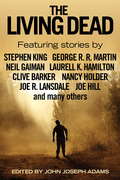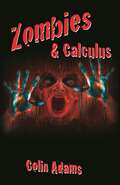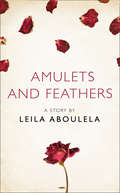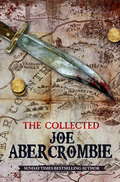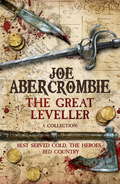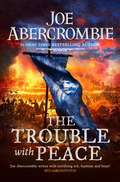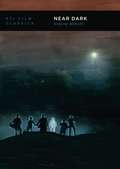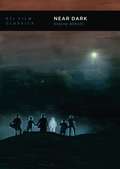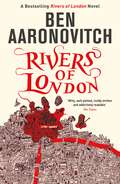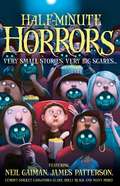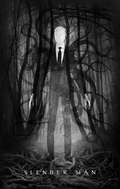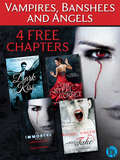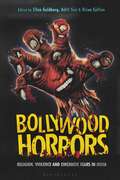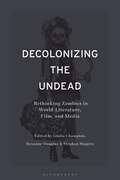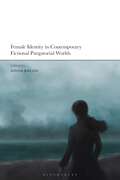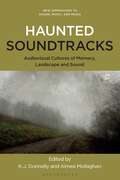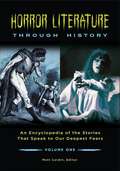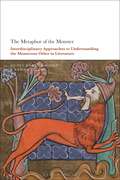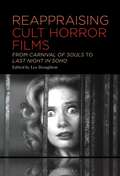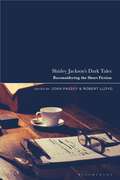- Table View
- List View
The Living Dead
by John Joseph AdamsAn anthology of zombie short fiction from some of the biggest names in horror and speculative fiction - including Stephen King, George R. R. Martin and Neil GaimanWhen there's no more room in hell, the dead will walk the earth!From White Zombie to Dawn of the Dead, Resident Evil to World War Z, zombies have invaded popular culture, becoming the monsters that best express the fears and anxieties of the modern west.Gathering together the best zombie literature of the last three decades from many of today's most renowned authors of fantasy, speculative fiction, and horror, including Stephen King, Harlan Ellison, Robert Silverberg, George R. R. Martin, Clive Barker, Poppy Z. Brite, Neil Gaiman, Joe Hill, Laurell K. Hamilton, and Joe R. Lansdale, The Living Dead covers the broad spectrum of zombie short fiction.Praise for THE LIVING DEAD:'The best collection of zombie fiction stories ever' - Barnes & Noble.com'Believe the hype. The Living Dead is absolutely the best zombie anthology I've ever read (and I've read many)... If you have even a vague interest in zombie fiction, you MUST buy this book' - Horrorscope'The Living Dead contains stories of heartbreak, drama, and man's eternal struggle against himself. The focus doesn't fall squarely on violence and horror, which earns it a place among the best of zombie fiction' - Robert Kirkman, writer of THE WALKING DEAD and MARVEL ZOMBIES'A superb reprint anthology that runs the gamut of zombie stories . . . There's some great storytelling for zombie fans as well as newcomers' - Publishers Weekly
Zombies and Calculus
by Colin AdamsHow can calculus help you survive the zombie apocalypse? Colin Adams, humor columnist for the Mathematical Intelligencer and one of today's most outlandish and entertaining popular math writers, demonstrates how in this zombie adventure novel.Zombies and Calculus is the account of Craig Williams, a math professor at a small liberal arts college in New England, who, in the middle of a calculus class, finds himself suddenly confronted by a late-arriving student whose hunger is not for knowledge. As the zombie virus spreads and civilization crumbles, Williams uses calculus to help his small band of survivors defeat the hordes of the undead. Along the way, readers learn how to avoid being eaten by taking advantage of the fact that zombies always point their tangent vector toward their target, and how to use exponential growth to determine the rate at which the virus is spreading. Williams also covers topics such as logistic growth, gravitational acceleration, predator-prey models, pursuit problems, the physics of combat, and more. With the aid of his story, you too can survive the zombie onslaught.Featuring easy-to-use appendixes that explain the book's mathematics in greater detail, Zombies and Calculus is suitable both for those who have only recently gotten the calculus bug, as well as for those whose disease has advanced to the multivariable stage.
Zombies and Calculus
by Colin AdamsHow can calculus help you survive the zombie apocalypse? Colin Adams, humor columnist for the Mathematical Intelligencer and one of today's most outlandish and entertaining popular math writers, demonstrates how in this zombie adventure novel.Zombies and Calculus is the account of Craig Williams, a math professor at a small liberal arts college in New England, who, in the middle of a calculus class, finds himself suddenly confronted by a late-arriving student whose hunger is not for knowledge. As the zombie virus spreads and civilization crumbles, Williams uses calculus to help his small band of survivors defeat the hordes of the undead. Along the way, readers learn how to avoid being eaten by taking advantage of the fact that zombies always point their tangent vector toward their target, and how to use exponential growth to determine the rate at which the virus is spreading. Williams also covers topics such as logistic growth, gravitational acceleration, predator-prey models, pursuit problems, the physics of combat, and more. With the aid of his story, you too can survive the zombie onslaught.Featuring easy-to-use appendixes that explain the book's mathematics in greater detail, Zombies and Calculus is suitable both for those who have only recently gotten the calculus bug, as well as for those whose disease has advanced to the multivariable stage.
Amulets and Feathers: A Story From The Collection, I Am Heathcliff
by Leila AboulelaA story from Leila Aboulela to stir the heart and awaken vital conversations about love.
The Collected Joe Abercrombie
by Joe Abercrombie'Joe Abercrombie is doing some terrific work' George R. R. Martin, author of GAME OF THRONES.Here are the first six books set in the world of THE FIRST LAW, Joe Abercrombie's hugely successful fantasy creation. Join Logen Ninefingers, Jezal dan luthar and Inquisitor Glokta as war rages across the North in the first trilogy, and then enjoy three self-contained novels and discover more of the remarkable imagination of the UK's most prominent fantasy author.Contains THE BLADE ITSELF, BEFORE THEY ARE HANGED, LAST ARGUMENT OF KINGS, BEST SERVED COLD, THE HEROES and RED COUNTRY
The Great Leveller: Best Served Cold, The Heroes and Red Country
by Joe AbercrombieCollected together for the first time, here are the three hard-hitting standalone novels set in the world of Joe Abercrombie's bestselling FIRST LAW trilogy.BEST SERVED COLD: War may be hell but for Monza Murcatto, the Snake of Talins, the most feared and famous mercenary in Duke Orso's employ, it's a damn good way of making money too. Her victories have made her popular - a shade too popular for her employer's taste. Betrayed, thrown down a mountain and left for dead, Murcatto's reward is a broken body and a burning hunger for vengeance. Whatever the cost, seven men must die.THE HEROES: Over three bloody days of battle, the fate of the North will be decided. But with both sides riddled by intrigues, follies, feuds and petty jealousies, it is unlikely to be the noblest hearts, or even the strongest arms that prevail. Three men. One battle. No Heroes.RED COUNTRY: Shy South hoped to bury her bloody past and ride away smiling, but she'll have to sharpen up some bad old ways to get her family back, and she's not a woman to flinch from what needs doing. She sets off in pursuit off her family's killers with only a pair of oxen and her cowardly old stepfather Lamb for company. But it turns out Lamb's buried a bloody past of his own, and out in the lawless Far Country, the past never stays buried.
The Trouble With Peace: Book Two (The Age of Madness #2)
by Joe AbercrombieSecond in the AGE OF MADNESS trilogy, THE TROUBLE WITH PEACE is the next instalment of a series which is revolutionising fantasy . . .Conspiracy. Betrayal. Rebellion.Peace is just another kind of battlefield . . .Savine dan Glokta, once Adua's most powerful investor, finds her judgement, fortune and reputation in tatters. But she still has all her ambitions, and no scruple will be permitted to stand in her way.For heroes like Leo dan Brock and Stour Nightfall, only happy with swords drawn, peace is an ordeal to end as soon as possible. But grievances must be nursed, power seized and allies gathered first, while Rikke must master the power of the Long Eye . . . before it kills her.Unrest worms into every layer of society. The Breakers still lurk in the shadows, plotting to free the common man from his shackles, while noblemen bicker for their own advantage. Orso struggles to find a safe path through the maze of knives that is politics, only for his enemies, and his debts, to multiply. The old ways are swept aside, and the old leaders with them, but those who would seize the reins of power will find no alliance, no friendship, and no peace, lasts forever.
Near Dark (BFI Film Classics)
by Stacey AbbottFirst released in 1987, Near Dark is a vampire film set in the contemporary American Midwest that tells the story of Caleb, a half-vampire trying to decide whether to embrace his vampire nature or return to his human family. The film, an early work of the now-established director Kathryn Bigelow, skilfully mixes genre conventions, combining gothic tropes with those of the Western, road movie and film noir, while also introducing elements of the outlaw romance genre.Stacey Abbott's study of the film addresses it as a genre hybrid that also challenges conventions of the vampire film. The vampires are morally ambiguous and undermine the class structures that have historically defined stories of the undead. These are not aristocrats but instead they capture the allure and horror of the disenfranchised and the underclass. As Abbott describes, Near Dark was crucial in consolidating Bigelow's standing as a director of significance at an early point in her career, not simply because of her visual art background, but because of the way in which she would from Near Dark onward re-envision other traditionally mainstream genres of filmmaking.
Near Dark (BFI Film Classics)
by Stacey AbbottFirst released in 1987, Near Dark is a vampire film set in the contemporary American Midwest that tells the story of Caleb, a half-vampire trying to decide whether to embrace his vampire nature or return to his human family. The film, an early work of the now-established director Kathryn Bigelow, skilfully mixes genre conventions, combining gothic tropes with those of the Western, road movie and film noir, while also introducing elements of the outlaw romance genre.Stacey Abbott's study of the film addresses it as a genre hybrid that also challenges conventions of the vampire film. The vampires are morally ambiguous and undermine the class structures that have historically defined stories of the undead. These are not aristocrats but instead they capture the allure and horror of the disenfranchised and the underclass. As Abbott describes, Near Dark was crucial in consolidating Bigelow's standing as a director of significance at an early point in her career, not simply because of her visual art background, but because of the way in which she would from Near Dark onward re-envision other traditionally mainstream genres of filmmaking.
Rivers of London: Book 1 in the #1 bestselling Rivers of London series (A Rivers of London novel #1)
by Ben AaronovitchBook 1 in the Rivers of London series, from Sunday Times Number One bestselling author Ben Aaronovitch.My name is Peter Grant, and I used to be a probationary constable in that mighty army for justice known to all right-thinking people as the Metropolitan Police Service, and to everyone else as the Filth. My story really begins when I tried to take a witness statement from a man who was already dead...Probationary Constable Peter Grant dreams of being a detective in London's Metropolitan Police. After taking a statement from an eyewitness who happens to be a ghost, Peter comes to the attention of Detective Chief Inspector Thomas Nightingale, who investigates crimes involving magic and other manifestations of the uncanny.Suddenly, as a wave of brutal and bizarre murders engulfs the city, Peter is plunged into a world where gods and goddesses mingle with mortals and a long-dead evil is making a comeback on a rising tide of magic.Praise for the Rivers of London novels:'Ben Aaronovitch has created a wonderful world full of mystery, magic and fantastic characters. I love being there more than the real London'NICK FROST'As brilliant and funny as ever'THE SUN'Charming, witty, exciting'THE INDEPENDENT'An incredibly fast-moving magical joyride for grown-ups'THE TIMESDiscover why this incredible series has sold over two million copies around the world. If you're a fan of Terry Pratchett or Douglas Adams - don't panic - you will love Ben Aaronovitch's imaginative, irreverent and all-round irresistible novels.
Bollywood Horrors: Religion, Violence and Cinematic Fears in India
Bollywood Horrors is a wide-ranging collection that examines the religious aspects of horror imagery, representations of real-life horror in the movies, and the ways in which Hindi films have projected cinematic fears onto the screen. Part one, “Material Cultures and Prehistories of Horror in South Asia” looks at horror movie posters and song booklets and the surprising role of religion in the importation of Gothic tropes into Indian films, told through the little-known story of Sir Devendra Prasad Varma. Part two, “Cinematic Horror, Iconography and Aesthetics” examines the stereotype of the tantric magician found in Indian literature beginning in the medieval period, cinematic representations of the myth of the fearsome goddess Durga's slaying of the Buffalo Demon, and the influence of epic mythology and Hollywood thrillers on the 2002 film Raaz. The final part, “Cultural Horror,” analyzes elements of horror in Indian cinema's depiction of human trafficking, shifting gender roles, the rape-revenge cycle, and communal violence.
Decolonizing the Undead: Rethinking Zombies in World-Literature, Film, and Media
Looking beyond Euro-Anglo-US centric zombie narratives, Decolonizing the Undead reconsiders representations and allegories constructed around this figure of the undead, probing its cultural and historical weight across different nations and its significance to postcolonial, decolonial, and neoliberal discourses. Taking stock of zombies as they appear in literature, film, and television from the Caribbean, Latin America, sub-Saharan Africa, India, Japan, and Iraq, this book explores how the undead reflect a plethora of experiences previously obscured by western preoccupations and anxieties. These include embodiment and dismemberment in Haitian revolutionary contexts; resistance and subversion to social realities in the Caribbean and Latin America; symbiosis of cultural, historical traditions with Western popular culture; the undead as feminist figures; as an allegory for migrant workers; as a critique to reconfigure socio-ecological relations between humans and nature; and as a means of voicing the plurality of stories from destroyed cities and war-zones. Interspersed with contextual explorations of the zombie narrative in American culture (such as zombie walks and the television series The Santa Clarita Diet) contributors examine such writers as Lowell R. Torres, Diego Velázquez Betancourt, Hemendra Kumar Roy, and Manabendra Pal; works like China Mieville's Covehithe, Reza Negarestani's Cycolonopedia, Julio Ortega's novel Adiós, Ayacucho, Ahmed Saadawi's Frankenstein in Baghdad; and films by Alejandro Brugués, Michael James Rowland, Steve McQueen, and many others. Far from just another zombie project, this is a vital study that teases out the important conversations among numerous cultures and nations embodied in this universally recognized figure of the undead.
Female Identity in Contemporary Fictional Purgatorial Worlds
Examining fictional purgatorial worlds in contemporary literature, film and video games, this book examines the way in which the female characters trapped within them construct identity positions of resistance and change. With the rise of populism, the Alt. Right, and isolationism in world politics in the second decade of the 21st Century, parallel, purgatorial worlds seem to currently proliferate within popular culture across all media, including television shows and films such as The Handmaids Tale, Us, Watchmen, and Margaret Atwood's The Testaments among many others. These texts depict alternate worlds that express the darkness and violence of our own, arguably none more so than for women. Featuring essays from a broad range of international contributors on topics as wide-ranging as mental health in the Silent Hill franchise and liminal spaces in the work of David Mitchell, this book is an original, timely and hope-filled analysis about overcoming the confines of a patriarchal, fundamentalist world where the female imaginative might just be the last, best hope.
Haunted Soundtracks: Audiovisual Cultures of Memory, Landscape, and Sound (New Approaches to Sound, Music, and Media)
The turn of the millennium has heralded an outgrowth of culture that demonstrates an awareness of the ephemeral nature of history and the complexity underpinning the relationship between location and the past. This has been especially apparent in the shifting relationship between landscape, memory and sound in film, television and other media. The result is growing interest in soundtracks, as part of audiovisual culture, as well as an interest in the spectral aspects of culture more generally. This collection of essays focuses on audiovisual forms that foreground landscape, sound and memory. The scope of inquiry emphasises the ghostly qualities of a certain body of soundtracks, extending beyond merely the idea of 'scary films' or 'haunted houses.' Rather, the notion of sonic haunting is tied to ideas of trauma, anxiety or nostalgia associated with spatial and temporal dislocation in contemporary society. Touchstones for the approach are the concepts of psychogeography and hauntology, pervasive and established critical strategies that are interrogated and refined in relation to the reification of the spectral within the soundtracks under consideration here.
Horror Literature through History [2 volumes]: An Encyclopedia of the Stories That Speak to Our Deepest Fears [2 volumes]
This two-volume set offers comprehensive coverage of horror literature that spans its deep history, dominant themes, significant works, and major authors, such as Stephen King, Edgar Allan Poe, and Anne Rice, as well as lesser-known horror writers.Many of today's horror story fans—who appreciate horror through movies, television, video games, graphic novels, and other forms—probably don't realize that horror literature is not only one of the most popular types of literature but one of the oldest. People have always been mesmerized by stories that speak to their deepest fears. Horror Literature through History shows 21st-century horror fans the literary sources of their favorite entertainment and the rich intrinsic value of horror literature in its own right. Through profiles of major authors, critical analyses of important works, and overview essays focused on horror during particular periods as well as on related issues such as religion, apocalypticism, social criticism, and gender, readers will discover the fascinating early roots and evolution of horror writings as well as the reciprocal influence of horror literature and horror cinema.This unique two-volume reference set provides wide coverage that is current and compelling to modern readers—who are of course also eager consumers of entertainment. In the first section, overview essays on horror during different historical periods situate works of horror literature within the social, cultural, historical, and intellectual currents of their respective eras, creating a seamless narrative of the genre's evolution from ancient times to the present. The second section demonstrates how otherwise unrelated works of horror have influenced each other, how horror subgenres have evolved, and how a broad range of topics within horror—such as ghosts, vampires, religion, and gender roles—have been handled across time. The set also provides alphabetically arranged reference entries on authors, works, and specialized topics that enable readers to zero in on information and concepts presented in the other sections.
The Metaphor of the Monster: Interdisciplinary Approaches to Understanding the Monstrous Other in Literature
The Metaphor of the Monster offers fresh perspectives and a variety of disciplinary approaches to the ever-broadening field of monster studies. The eclectic group of contributors to this volume represents areas of study not generally considered under the purview of monster studies, including world literature, classical studies, philosophy, ecocriticism, animal ethics, and gender studies. Combining historical overviews with contemporary and global outlooks, this volume recontextualizes the monstrous entities that have always haunted the human imagination in the age of the Anthropocene. It also invites reflection on new forms of monstrosity in an era epitomized by an unprecedented deluge of (mis)information. Uniting researchers from varied academic backgrounds in a common effort to challenge the monstrous labels that have historically been imposed upon "the Other," this book endeavors above all to bring the monster out of the shadows and into the light of moral consideration.
Nosferatu in the 21st Century: A Critical Study
‘Nosferatu’ in the 21st Century is a celebration and a critical study of F. W. Murnau’s seminal vampire film Nosferatu, eine Symphonie des Grauens on the 100th anniversary of its release in 1922. The movie remains a dark mirror to the troubled world we live in seeing it as striking and important in the 2020s as it was a century ago. The unmistakable image of Count Orlok has traveled from his dilapidated castle in old world Transylvania into the futuristic depths of outerspace in Star Trek and beyond as the all-consuming shadow of the vampire spreads ever wider throughout contemporary popular culture. This innovative collection of essays, with a foreword by renowned Dracula expert Gary D. Rhodes, brings together experts in the field alongside creative artists to explore the ongoing impact of Murnau’s groundbreaking movie as it has been adapted, reinterpreted, and recreated across multiple mediums from theatre, performance and film, to gaming, music and even drag. As such, ‘Nosferatu’ in the 21st Century is not only a timely and essential book about Murnau’s film but also illuminates the times that produced it and the world it continues to influence.
Reappraising Cult Horror Films: From Carnival of Souls to Last Night in Soho
Identifies key – and in some cases previously overlooked – cult horror films from around the world and reappraises them by approaching and interrogating them in new ways.New productions in the horror genre occupy a prominent space within the cinematic landscape of the 21st century, but the genre's back catalogue of older films refuses to be consigned to the motion picture graveyard just yet. Interest in older horror films remains high, and an ever-increasing number of these films have enjoyed an afterlife as cult movies thanks to regular film festival screenings, television broadcasts and home video releases. Similarly, academic interest in the horror genre has remained high. The frameworks applied by contributors to the collection include genre studies, narrative theory, socio-political readings, aspects of cultural studies, gendered readings, archival research, fan culture work, interviews with filmmakers, aspects of film historiography, spatial theory and cult film theory. Covering a corpus of films that ranges from recognised cult horror classics such as The Wicker Man, The Shining and Candyman to more obscure films like Daughters of Darkness, The Legend of the 7 Golden Vampires, Shivers, Howling III: The Marsupials and Inside, Broughton has curated an international selection of case studies that show the diverse nature of the cult horror subgenre. Be they star-laden, stylish, violent, bizarre or simply little heard-of obscurities, this book offers a multitude of new critical insights into a truly eclectic selection of cult horror films.
Shirley Jackson’s Dark Tales: Reconsidering the Short Fiction
The first dedicated exploration of the short fiction of Shirley Jackson for three decades, this volume takes an in-depth look at the themes and legacies of her 200-plus short stories. Recognized as the mother of contemporary horror, scholars from across the globe, and from a range of different disciplinary backgrounds, dig into the lasting impact of her work in light of its increasing relevance to contemporary critical preoccupations and the re-release of Jackson's work in 2016. Offering new methodologies to study her work, this volume calls upon ideas of intertextuality, ecocriticism and psychoanalysis to examine a broad range of themes from national identity, race, gender and class to domesticity, the occult, selfhood and mental illness. With consideration of her blockbuster works alongside later works that received much less critical attention, Shirley Jackson's Dark Tales promises a rich and dynamic expansion on previous scholarship of Jackson's oeuvre, both bringing her writing into the contemporary conversation, and ensuring her place in the canon of Horror fiction.
Walter de la Mare: Critical Appraisals (Liverpool English Texts and Studies #95)
This book aims to put Walter de la Mare back on the literary map. A writer beloved by many, he has nevertheless remained on the sidelines of literary history. Walter de la Mare: Critical Appraisals promises to restore his reputation as one of the most memorably haunting of poets, as well as a peculiarly unnerving writer of ghost stories. A collection of varied, wide-ranging essays on de la Mare’s poetry, stories, novels, reviews and lectures, it puts his work beside that of many of his famous contemporaries, including Thomas Hardy, Robert Frost, W. H. Auden, T. S. Eliot and Katherine Mansfield. It also contains an invaluable survey of his archive, much of it unpublished, and a number of newly commissioned poems reflecting on his legacy. This multifaceted volume will be of interest to students working on twentieth-century poetry, the short story, the nature and limits of modernism and British intellectual history, as well as on de la Mare himself.List of contributors: Catherine Charlwood, Guy Cuthbertson, Peter Davidson, Giles de la Mare, Andrew Doyle, Suzannah V. Evans, Adam Guy, Robin Holloway, Yui Kajita, Zaffar Kunial, Gregory Leadbetter, Angela Leighton, Erica McAlpine, Jenny McDonnell, Will May, Andrew Motion, Paul Muldoon, A. J. Nickerson, Seamus Perry, Adrian Poole, Camille Ralphs, Vidyan Ravinthiran, Peter Scupham, A. E. Stallings, Mark Valentine, Rory Waterman, Anne Welsh, David Wheatley, Rowan Williams, William Wootten.
